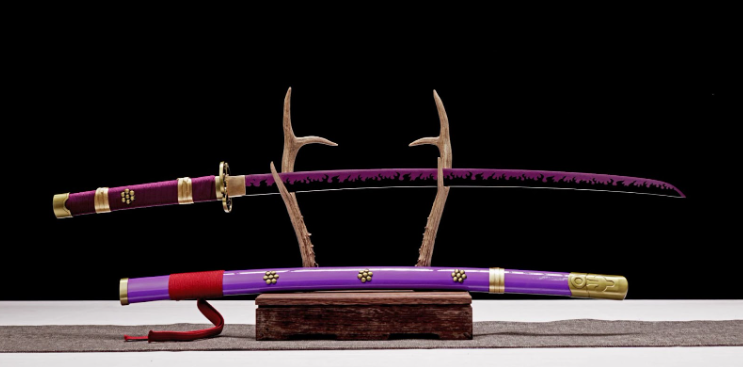
In `Demon Slayer`, the moment a warrior unsheathes a sword, the blade flashes with color. That quick shine is more than show; each Nichirin sword carries a message about its owner, their breathing style, and the fight inside them. Learning what those colors stand for turns a fun watch into a deeper look at Koyoharu Gotouge’s rich world.
The Demon Slayer Corps depends on these unique weapons because regular steel can’t touch the monsters they hunt. A sword’s color appears during the forging process, when the metal and the fighter’s spirit are fused. That bond between person and blade gives anime fans one of the coolest weapon systems around—where hue doubles as character growth.
What Are Nichirin Blades?
Nichirin blades are the crown jewels of demon-slaying gear in the series. Craftsmen shape the swords using Scarlet Crimson Iron Sand and Scarlet Crimson Ore. Those rare ores soak up sunlight, the only force strong enough to end a demon for good.
Forging a Nichirin blade is not just a job for many swordsmiths; it’s the center of their life’s work. These craftsmen spend years standing in front of roaring forges, swinging hammers, and studying every spark. Heat treatments and specific chanting rituals follow the hammering so that the completed sword can almost hear the breath of its future owner. When the sword is finally finished, it can cut through flesh and bone, and still leave behind a burn like being touched by sunlight.
What really sets a Nichirin blade apart is that its true color springs to life the first time its owner draws it. Until that moment, the blade looks like plain steel. As soon as the wielder grips the handle, a bright hue—red, green, blue—erupts along the edge, showing a direct link between user and weapon. That color never fades or changes; it stays true for as long as the blade exists, making every sword as personal as a fingerprint.
Master swordsmiths, from the famous Haganezuka to the skilled artisans who work in the shadows, pass down secrets through families. They mix ancient Japanese hammer-and-anvil methods with strange techniques most outsiders would call magic. Thanks to this blend, ordinary humans can stand toe-to-toe with demons that shrug off normal steel.
The Meng Behind Each Sword Color
Red: The Flame of Determination
When a Nichirin sword turns red, it almost crackles with the same energy that fuels the fighter holding it. Kyojuro Rengoku’s bright crimson blade perfectly matches his Fire Breathing style, pouring every ounce of his fierce determination into the steel. This color isn’t just about flamboyance; it stands for a willingness to put everything on the line to guard others, even if that means sacrificing your own life.
That fiery hue speaks to the heart of a true warrior, someone who charges toward danger without looking back. Red-blade users often end up as natural leaders because their enthusiasm is so contagious—and because people naturally want to follow someone who burns with such inner light. They light the way, showing everyone around them that hope is still alive.
Curiously, Tanjiro’s sword also goes red during life-or-death moments, hinting at the deeper roots he shares with the legendary Sun Breathing art. That sudden change shows how a sword’s color can shift when the wielder unlocks hidden layers of spirit strength.
Blue: Clarity and Precision
In contrast, blue Nichirin blades offer a cool, steady light that whispers of calm focus and razor-clear strategy. Giyu Tomioka’s striking azure sword mirrors the Water Breathing style nearly perfectly, flowing like a stream while landing each cut exactly where it needs to go. Wielders of the blue blade treat battle less like a raging wildfire and more like a chess game, mapping out moves and counters rather than letting gut feeling carry the day.
Blue: Calm Precision
Blue Nichirin blades stand for mental clarity and the ability to stay cool when the heat is on. Forged from this spirit, their users often take on the job of the team’s tactical brain, spotting solutions when everyone else sees a brick wall. Because of that focus, their fighting style leans toward technique rather than raw muscle; every step, swing, and breath has a reason, so their movements look almost choreographed.
The blade’s link to water adds a second layer of meaning: adaptability. Like a stream that bends around rocks, blue-blade combatants flow with the fight, slipping through openings and striking hard while staying out of danger themselves. This flexible mindset turns out to be especially useful against demons that charge in swinging, since brute power often falters against a strategy that simply refuses to break.
Green: Nature’s Balance
Green Nichirin blades capture the fine line between aggression and restraint that we see everywhere in nature. As a result, the breathing forms tied to the color borrow ideas from storms, forests, and oceans, asking fighters to keep their muscles in sync with their spirits so neither overshadows the other.
Growth, renewal, and quiet but iron-willed resilience are the blade’s heart. People who carry it usually possess a gut-level sense of life’s seasons—how trees lose leaves before spring, how rivers carve caves over centuries—and they fight to keep demons from corrupting that steady cycle. By protecting order in nature, they also protect order in people, making them guardians in every sense of the word.
Yellow/Gold: Bright Courage
Yellow and gold Nichirin blades sparkle like morning sunshine, reminding everyone around the wielder that true courage is always glowing somewhere inside. Zenitsu’s golden sword, guided by his Thunder Breathing, shows how a person who sweats bullets can still jump into battle and do something amazing. Those warm colors stand for an inner spark too tough to be snuffed out by fear.
People with gold blades often fight a quiet war of self-doubt, yet when a friend is in danger, their hidden bravery bursts free like lightning. Gold stands for the quick, split-second choices heroes make—the moments when a shaky heart suddenly decides to move without thinking.
That bright, electric shade tells us the wielder can strike like a storm, hitting with speed and accuracy before anyone even sees it coming. The color is a promise of energy stored up and ready to explode at the right heartbeat.
Purple: Quiet Mystery
Purple Nichirin blades feel like moonlight—beautiful, strange, and a little hard to pin down. You’ll usually find this color in the hands of fighters who bend the Breath Styles into something new, refusing to fit inside a box. Deep purple shows how two opposites can meet and learn to dance together, carrying the wisdom that life is rarely only black or white.
Shinobu Kocho’s poison-laced moves are a perfect example; her purple blade bites before you even notice it has struck. She uses her sharp mind to build clever tricks that make up for what her body can’t do with raw power.
Gray and Black: Potential Waiting to Be Found
When a Nichirin sword comes out gray or black, it tells everyone that the user hasn’t finished writing their story yet. These dark hues pop up on fighters whose breathing styles are still growing or who simply haven’t tapped into all they can do. Think of their blade colors as blank pages waiting for a hero to fill them.
Inosuke Hashibira started out swinging gray blades that matched the wild, noisy way he fought. Once he trained with others and learned how to fit inside the Demon Slayer Corps, those blades turned black, mirroring his sharper skills and clearer sense of himself. Same with Tanjiro—his original black steel says he, too, is made for huge things once he discovers the full length of his string of fate.
Indigo: Wisdom Forged in Experience
An indigo blade shines when a swordsman no longer only reacts, but genuinely understands why they fight. This color signals that the user has mastered their breathing style and explored the deeper, almost philosophical side of hunting demons. The hue sits between dark blue night and sad dawn, reminding us that true courage often sits in the gray space where monsters and heroes meet.
Because of this, indigo users often play the role of translator, guiding teammates through the brawl while reminding them of what is at stake beyond only winning. Their calm yet fierce presence can turn a wild fight into a focused mission.
Pink: Love That Packs a Punch
When you see pink in a Nichirin blade, get ready for love dressed in battle gear. Mitsuri Kanroji’s sword, humming with her unique Love Breathing, shows that gentle hearts grow the tallest trunks—even when planted in the toughest soil. The moment someone she cares about is in danger, that pink steel blazes with power that could split a boulder.
Pink: Love Over Hatred
A pink Nichirin blade is more than just a pretty color; it shows a warrior who fights out of love, not anger. People who swing a pink sword usually read the room better than most. Their strong feelings help them comfort others and spark courage when times get tough. That emotional smarts turns battles into chances to lift everyone around them.
White: Unshakeable Purpose
White blades shine because their owners have crystal-clear goals. These swords are rare, appearing only in the hands of fighters whose moves, feelings, and dreams line up as one. The glow of the blade stands for zero doubt and total commitment. When someone swings a white sword, you can bet every ounce of energy is going toward what they believe is right.
Colors and Growth
The colors of Nichirin blades do much more than look cool; they tell the story of the person holding them. Each hue acts like a badge, showing where a warrior has been and how far they’ve come. Take Tanjiro, for example. He first carries a black blade, a sign that he’s new to the demon-slaying world and still finding his feet. As he trains and learns about the legendary Sun Breathing style, his sword finally bursts into a fiery red, signaling that he has matured into a true master who understands the battle on a deeper level.
Zenitsu’s bright-yellow Nichirin blade is a perfect symbol for him, even if not everyone realizes it right away. Out in public, he comes off as jumpy and terrified of every demon—and maybe even of his own shadow. Yet in battle, that same flashy sword flashes like a lightning bolt, showing a measure of bravery he rarely admits he has. The color doesn’t lie; it marks him as a Storm Pillar in the making, the kind of fighter who can summon the sky when he finally dares to trust himself.
Across the Demon Slayer Sword ranks, each sword color pretty much sticks to its owner, almost like a personal brand. Look at Giyu and his piercing blue blade, which matches his cool demeanor and unshakeable resolve. No matter how much the story twists, that hue reminds us that he is steady, calm, and ever-watchful. The colors may not change, but small tweaks in how the character wields the sword show us they still grow. Even the most rigid traits can bend and stretch under the right pressure, without ever losing the core shade that defines them.
